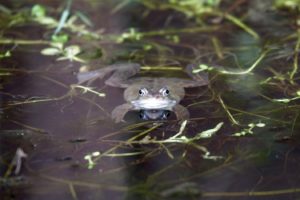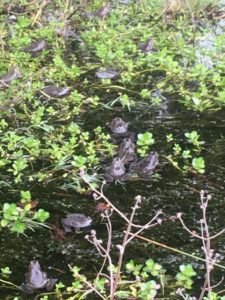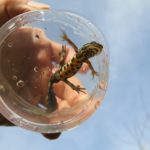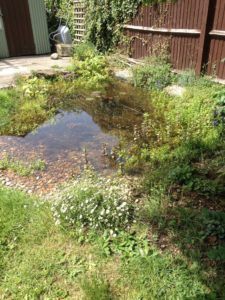Did you know the once common toad is in trouble, populations have declined across the UK by 68% over the past 30 years? Worryingly, there was a 17% reduction in regular sightings of common frogs in gardens between 2014 and 2018. Many of us had our first wildlife encounters with these creatures; catching tadpoles and frogs are a fond childhood memory for many people.

Much of this decline is thought to be due to habitat loss. Most farms used to have ponds that were used as sources of water but as farming has intensified many of these ponds have been filled in or reverted to scrub. Further breeding habitat has been lost due to the draining of land for building on and pollution of some water bodies.

Frog populations appear to be doing better in towns and cities and this is no doubt down to the great habitat that can be created in our gardens.
It’s easy to create a small pond and frogs can thrive in amongst our flower beds and under our hedges. Toads will sometimes use a greenhouse and it’s amazing where newts turn up too! Read on for our top tips to attract these magnificent creatures to your garden. They’ll repay the favour by providing some free pest control – they love slugs!
How can you help Frogs, Toads and Newts?
Create a garden pond
Frogs and newts will happily use small ponds – my first one was made out of an old kitchen sink! They don’t need to be huge or deep; shallow-sided wildlife ponds that do not contain fish are best. You’ll be amazed at what else they attract, from bathing birds to dragonflies and beetles.

If you’re worried about pets or children you can fence the pond in or put a cover over it, but my personal experience is that with a shallow-sided pond children soon learn about water and how to behave around it. It can be an important life lesson in their own back garden, with you supervising.
Go to https://freshwaterhabitats.org.uk/pond-clinic/create-pond/make-garden-pond/ for a step-by-step guide. Your local Wildlife Trust has great advice here for creating a mini pond https://www.bbowt.org.uk/actions/how-create-mini-pond.
Add a log pile or hibernacula

Most amphibians only spend a small part of the year in ponds and need other sheltered habitat for the rest of the year. Even if you can’t have a pond, you can provide good habitat for them by creating a log pile or placing logs under the base of a hedge or back of a flower bed. A pile of large flat stones can be a great home for a toad and I’ve found many newts hiding in piles of bricks!
A hibernaculum is a purpose-made place for amphibians to hibernate – crucial for them to survive from year to year and easy to make. Find out how here: https://www.wildlifewatch.org.uk/what-is-a-hibernaculum
Create wild areas for amphibians to hide and feed
Amphibians need somewhere to hide and to feed so areas of longer grass and flower beds play a critical role in helping them thrive. Combined with any of the other features you’ll be creating a paradise for frogs, toads and newts.
Back to The Mix main page.
Wild Wantage images ©Mark Bradfield / Lucy Duerdoth

